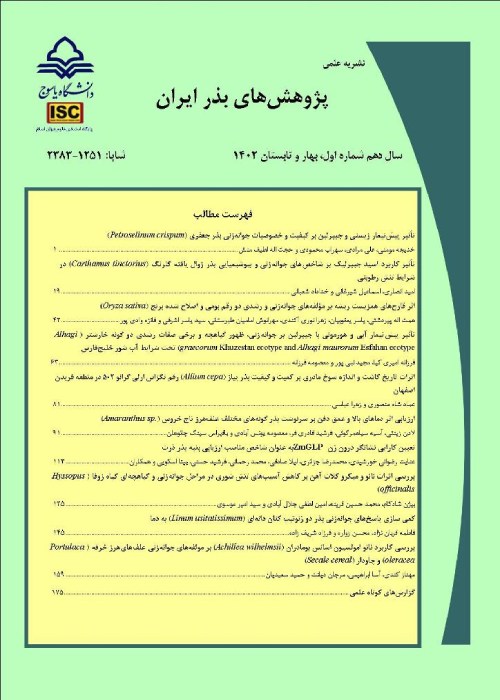Quantification of Phenolic Compounds and Evaluation of Allelopathic Potential of Wheat Cultivars on Wild Mustard (Sinapis arvensis) Seed Germination Indices
One of the biological methods of weed control is the use of allelopathic substances or herbal secretions that have the potential to inhibit growth weeds. Wheat allelopathic studies include the study of wheat allelopathy against other crops, weeds, pests and diseases, isolation and identification of allelopathic compounds, the effects of wheat toxicity on self-storage and management of wheat residues. Wild mustard (Sinapis arvensis) is a problematic weed in the country, especially in Golestan province. The present study was conducted to investigate the allelopathic potential of four wheat cultivars to use those cultivars in integrated weed management system to reduction growth mustard weed.
A factorial experiment was conducted in completely randomized design with three replications at Physiology Laboratory of Golestan Agricultural Research Center. Treatments included concentrations of 0, 2.5, 5, and 7.5% aqueous extract of aerial and underground organs of four wheat cultivars (Morvarid, Moghan, Tajan, and Arta) with 6000 polyethylene glycol treatment in four concentration (zero, 2.5, 5, and 7.5 percent). Three-parameter logistic model was used to evaluate the allelopathic potential of wheat genotypes for reducing the percentage of wild mustard germination and liquid chromatography (HPLC) was used to determine the phenolic acids composition in wheat cultivar extract.
Extract of shoot of all wheat cultivars reduced root length of wild mustard in comparison of control. Wheat cultivars reduced shoot length of wild mustard by 28% to 51% compared to control. The highest reduction in mustard shoot length was obtained from the Morvarid extract. Increase in shoot extract concentration of Arta to 7.5%, reduced root and shoot dry weight as 47 and 29% in compare of control treatment and Moghan cultivar in the same concentration (7.5%) caused reduction in root and shoot dry weight with 68 and 41% respectively. The highest reduction in germination indices of wild mustard was obtained from high concentrations of Morvarid and Moghan wheat extract. It was also found that with increasing concentration of polyethylene glycol (PEG) growth indices and germination components of wild mustard seed decreased, but this decrease was not significant. This confirms that the osmotic potential of the extract concentration is not involved in the exacerbation of the allelochemical effect and the likelihood of osmotic effect seems poor. In total, Morvarid cultivar with 25.34 mg phenolic acid content had the highest phenolic acid concentration, which was approximately three times more than that of Tajan, 1.5 times Moghan and three times of Arta cultivar. Morvarid cultivar had higher concentration of vanillic acid and ferulic acid than the other three cultivars. Overall, the least allelopathic effect was observed in Tajan cultivar and the most allelopathic effect was in Morvarid cultivar.
Among the cultivars studied, the highest inhibition was related to Morvarid cultivar. The results also showed that the highest amount of inhibition was related to shoot extract so that the root extract inhibition was less than the shoot on studied traits. In general, the results of the present study showed that some wheat cultivars have greater inhibitory potential against wild mustard weed, which can be used in breeding programs to produce cultivar with high allelopathic potential. Awareness of this issue is more important, especially in sustainable weed-management. Therefore, it is suitable to perform comprehensive studies on their allelopathic potential so that they can be used in agriculture, including combating with weeds, pests and plant diseases, breeding crop and horticulture, design herbicides and pesticides that is provide environmentally friendly, safe, and biodegradable.
- حق عضویت دریافتی صرف حمایت از نشریات عضو و نگهداری، تکمیل و توسعه مگیران میشود.
- پرداخت حق اشتراک و دانلود مقالات اجازه بازنشر آن در سایر رسانههای چاپی و دیجیتال را به کاربر نمیدهد.



